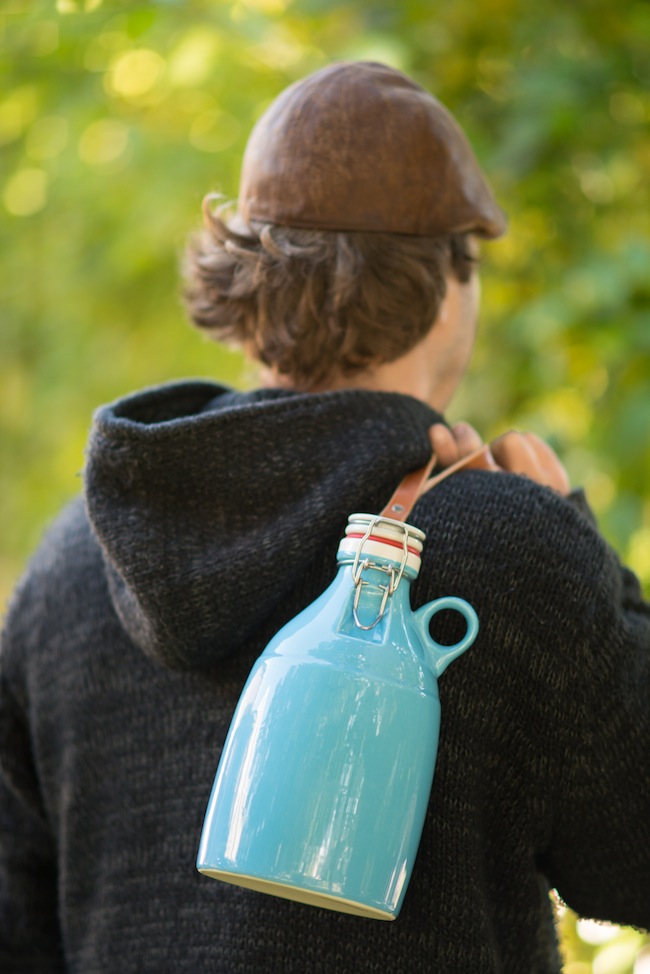Few things feel better than bringing home a growler full of cold beer from your favorite taproom, but the experience gains a lot when the vessel is aesthetically (and functionally) distinctive and—in the case of the Portland Growler Company—high quality ceramics.
The growler dates back to the late 1800s. From their inception, “rushing the growler” involved “bucket” boys and girls filling up growlers at local bars and delivering them to workers during their lunch break. Parents had their children “rush the growler” so that they could have fresh beer after their long day of work. Prohibition forbade minors from buying beer and laws that required liquor stores to close on Sundays led to the stealth growler, the “duck,” a closed metal flask that would go undetected inside the underarm of an overcoat.
The growler made a comeback in 1980 with the rise of home crafted beer. In 2010 the Portland Growler Company of Oregon, a collective of designers, potters, and ceramists, formed to “fill the void of hearty handmade growlers in a city full of brewers,” and to add a little contemporary style to the product.
The jugs are slip-cast from local clay and are made extra-thick to hold in the cold. The growlers are colored in several types of glazes, come with a metal-locking gasket, and some sport a sprocket-like handle for a very secure grip—particularly helpful after the tenth swig. They are great for the outdoors and, of course, the uses are not restricted to beer. It’s a cool way to serve water at the dinner table or to keep various carbonated drinks sealed in the fridge. And aside from that, they are beautiful enough to be simply decorative. It’s the best looker we have encountered in growler world. Add to that, it is a perfect gift for the beer snob in your life. (Don’t ever try to buy them beer!)
Also, growlers are eco friendly. Every 1,000 beer drinkers in the USA who go to the tap instead of the supermarket save 225,000 beer cans form ending in the city dump. And it gets better (or worse) depending upon your drinking habits. To protect the aluminum from leaching into the beverage, can interiors have a coating of epoxy resin. This often contains Bisphenol A (BPA) and tests by the Environmental Working Group suggest that BPA can cause cancer, infertility, miscarriages, polycystic ovarian disease, and insulin resistance. The plastic 6-pack rings are extremely dangerous for sea creatures and wildlife if they aren’t properly cut and recycled.
Artisan growlers are recommend because they last longer, are a pleasure to use and—unlike commercial ones from breweries—they do not have the cheap screw-on metal lids that can rust after as little as one use, causing beer to go flat.
CFile played a small role in the Portland Growler Company’s growth. A founder of the company, Brett Binford, remembers that he attended a lecture at PNCA (Pacific Northwest College of Art) by CFile Editor in Chief, Garth Clark who was delivering, “How Envy Killed the Crafts.” Binford wrote, “We were just growing our business in the basement at that time and your lecture at PNCA was so true about the need to find a space between studio and factory. It stuck with us through all of our long days weeks and months for the last five years.”
Bill Rodgers is a Contributing Editor at CFile.
CFile learned of this project through our submissions process. We welcome our readers to submit their own work for publication.
Above image: One of Portland Growler Company’s growlers on the go. Photograph courtesy of the designers in collaboration with Walnut Studiolo.
These handmade ceramic growlers by the Portland Growler Company are about to be filled with delicious, nutritious beer.

The Sprocket Growlette by the Portland Growler Company.



Growlers by the Portland Growler Company. Images courtesy of the designers.


Promotional photographs from the Portland Growler Company. Nothing says “Portland” like taking your designer beer growlers home in a bicycle basket. Photographs courtesy of the designers in collaboration with Walnut Studiolo.

The Portland Growler Company staff. Image courtesy of the designers.
Visit the Portland Growler Company

Do you sell these? I found one in a thrift store in Ventura California it’s blue pretty cool. Someone said they were Starbucks yet mine is blank I realized they are yours for beer I’d I’m correct. Do you sell these individually? Thank you I love it